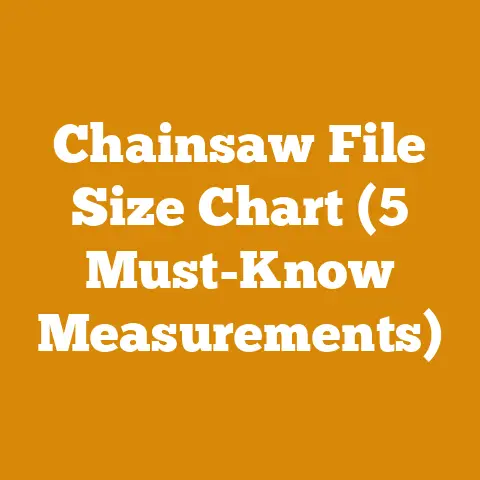How to Keep Chainsaw Bar Oil from Leaking (4 Fixes)
If you’re like me, your chainsaw is a trusty companion in the yard or out in the woods. But there’s one pesky issue that can really grind our gears—leaking bar oil. Let’s dive into how we can tackle this common annoyance with some straightforward fixes.
My Chainsaw Story
I remember the first time I bought my chainsaw. My excitement was through the roof as I envisioned all the projects I could tackle. However, my enthusiasm was quickly dampened by an unexpected oil slick under my new tool. I felt like a rookie in the chainsaw world, but over time, and with plenty of trial and error, I figured out how to manage this issue effectively. Let’s take a look at these solutions.
Why Does Bar Oil Leak?
Bar oil leakage usually happens because the oil continues to flow even when the chainsaw is off. This can occur due to several reasons, like worn-out parts, incorrect storage, or even using the wrong type of oil. But don’t worry, I’ve got some handy fixes for you.
Understanding Bar Oil Functionality
Bar oil is essential for lubricating the chainsaw chain and bar. It reduces friction and prevents premature wear. Without proper lubrication, the performance of your chainsaw can be severely compromised. However, too much oil or leaks can lead to messy situations and potential hazards.
Prerequisites and Required Materials
Before we jump into the fixes, here’s what you’ll need:
- Screwdriver set: For opening up parts of the chainsaw.
- Replacement oil cap: In case yours is faulty.
- Cleaning cloths: To clean up any mess.
- Sealant or gasket material: For fixing leaks.
- Correct bar oil: Make sure it’s the right type for your chainsaw.
Safety Precautions
- Turn Off and Cool Down: Always make sure your chainsaw is off and cool before working on it.
- Protective Gear: Wear gloves and eye protection to avoid injuries.
- Ventilation: Work in a well-ventilated area to avoid inhaling fumes from oil or cleaning agents.
Fix 1: Check and Replace the Oil Cap
Step 1: Inspect the Oil Cap
The first thing I always do is check the oil cap. If it’s cracked or not sealing properly, oil will leak out. I learned this the hard way during a project when I overlooked a tiny crack in the cap.
Step 2: Replace if Necessary
If you find any damage, replace the oil cap. It’s a simple fix but often solves the problem. Remember that not all caps are universal, so ensure you get one that matches your chainsaw model.
Pro Tip
Always ensure your oil cap is tightly secured after refilling. A loose cap is a common culprit for leaks.
Fix 2: Proper Storage Techniques
Step 1: Drain the Oil
After using the chainsaw, drain the bar oil if you won’t be using it for a while. This prevents gravity from pulling oil through the system. I remember storing my chainsaw in my garage without draining it and finding a pool of oil later.
Step 2: Store Correctly
Store your chainsaw on its side with the oil cap facing up. This helps prevent any residual oil from leaking out. If you’re storing it long-term, consider placing it in a plastic tray to catch any drips.
Warning!
Never store your chainsaw with a full tank of oil for extended periods; this increases leakage chances.
Fix 3: Clean or Replace Oil Lines
Step 1: Locate Oil Lines
Find where your chainsaw’s oil lines are located. These are usually small tubes that run from the oil tank to the bar. It’s crucial to understand your chainsaw’s anatomy before diving in.
Step 2: Clean the Lines
Use a cloth to clean any debris or buildup from these lines. Dirt can cause blockages or leaks. During one maintenance session, I found wood shavings blocking an oil line—cleaning it made all the difference.
Step 3: Replace if Needed
If cleaning doesn’t help, consider replacing old or cracked lines with new ones. Ensure you’re using compatible parts for your specific chainsaw model.
Maintenance Tip
Regularly check these lines for wear and tear during routine maintenance sessions.
Fix 4: Use the Right Bar Oil
Step 1: Check Your Manual
Your chainsaw manual will recommend a specific type of bar oil. Using the wrong oil can increase leakage. My neighbor once used motor oil instead of bar oil, and it led to excessive leaking and poor performance.
Step 2: Purchase Correct Oil
Make sure to buy the right viscosity of bar oil as per your manual’s recommendations. Thicker oils may not flow well in cold conditions, while thinner oils might leak more in warmer temperatures.
Personal Experience
I’ve experimented with different brands and types of bar oil over time. Some oils have additives that help reduce sling-off and improve adhesion to the chain.
Advanced Troubleshooting Tips
Inspect Seals and Gaskets
Over time, seals and gaskets can wear out, leading to leaks. Inspect these components regularly and replace them if they show signs of damage or deterioration.
Monitor Usage Patterns
Consider how you’re using your chainsaw. Long periods of idling or running at low throttle can cause excess oil buildup and leakage.
Upgrade Components
For those who frequently use their chainsaws, consider upgrading to high-quality components that offer better durability and performance.
Common Questions and Concerns
Q: Why does my chainsaw leak even when stored properly? A: It might be due to worn-out seals or gaskets needing replacement.
Q: How often should I replace my oil cap? A: Replace it whenever you notice damage or every couple of years as a precaution.
Q: Can environmental factors affect leakage? A: Yes, extreme temperatures can cause expansion or contraction of components, affecting seals and increasing leakage.
Conclusion and Next Steps
Keeping your chainsaw in top shape requires some TLC, but these fixes can really make a difference in preventing those annoying oil leaks. Regular maintenance and using the right products will save you headaches down the line.
Final Reminders
- Conduct regular inspections.
- Use proper storage techniques.
- Choose quality materials for repairs and replacements.
FAQs
Q: Can I use motor oil instead of bar oil? A: It’s not recommended since motor oil doesn’t have the same adhesive properties as bar oil.
Q: Is it normal for some oil to leak? A: A small amount might be normal due to residuals, but large leaks shouldn’t be ignored.
Q: How can I tell if my oil lines are clogged? A: If you notice reduced lubrication or unusual noises during operation, your lines might be clogged.
Now go grab your tools and get your chainsaw back in action, leak-free! With these insights and tips under your belt, you’re well-equipped to handle any bar oil issues like a pro. Happy cutting!






